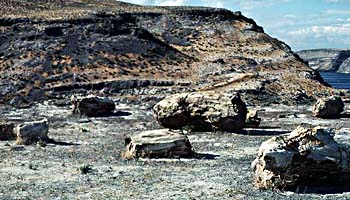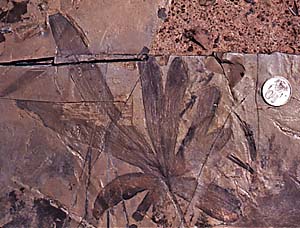



Ginkgoales: Fossil Record




The genus Ginkgo, represented today by the widely-cultivated Chinese species Ginkgo biloba, has an evolutionary lineage that dates back to the Lower Jurassic, about 190 million years ago. Although this genus has undergone much change over this length of time, fossilized leaf material from the Tertiary species Ginkgo adiantoides is considered similar or even identical to that produced by modern Ginkgo biloba trees.
The oldest fossils come from a single location in what is now the Asiatic part of the former USSR. During the Middle Jurassic there was a great increase in ginkgo fossil sites throughout the northern parts of the Laurasian supercontinent. At least two species existed at this time. Maximum diversity was reached during the Cretaceous with five or six species identified in the Northern Hemisphere. These species are mainly distinguishable on the basis of leaf anatomy and geographical distribution.

By the Paleocene, diversity in the genus Ginkgo was reduced to a single polymorphic species, often referred to as Ginkgo adiantoides, which produced leaves virtually indistinguishable from modern-day Ginkgo biloba. This species was mainly distributed in the northern regions due to the tropical environment at that time. As the Earth's climate cooled during the Oligocene, the species took on a more southerly distribution than it had occupied previously. In addition, the number of fossil sites decreases sharply. Approximately seven million years ago it disappeared from the fossil record of North America.
Although Ginkgo adiantoides was particularly abundant in Europe at the start of the Pliocene, it was gone from that region by about 2.5 million years ago. There are very limited numbers of fossils found from the Pliocene, and for the Pleistocene, no fossils of Ginkgo are known. Scientists thought that the genus had become extinct, however, through mysterious events, Ginkgo biloba managed to survive in China until modern times. These ginkgoes were mainly found in monasteries in the mountains, where they were cultivated by Buddhist monks. The ginkgo was brought out of these mountains by approximately 1100 AD and spread quickly throughout temperate Asia. It was first planted in Europe in the early 1700's and in America later that century.

The earliest fossils assigned to the Ginkgoales come from the Permian, though some of these do not clearly belong in this group. Both Trichopitys and Polyspermophyllum, from the Lower Permian, have forking leaves and short, forking, ovule-bearing appendages that closely resemble features of Ginkgo. Both of these have been compared to other seed plant groups.
Traditionally, paleobotanists have recognized related fossil ginkgo genera called Baiera and Ginkgoites. More recently, many workers reject this classification because it is ill-defined. The only major distinction between Ginkgo and Baiera is that Ginkgo is used for leaves with more than four veins per segment and Baiera for forms with fewer than four veins per segment. Another related genus is Sphenobaiera, with a broadly wedge-shaped leaf without a distinct petiole. Many scientists believe that these characteristics are within the limits of intra-genus variation, and therefore subsume these into Ginkgo as well.
Many Ginkgo species, including Ginkgoites and Baiera, were reported from various localities and stratigraphical horizons of younger Mesozoic age in northeast China under the generic names of Ginkgo, Baiera, and Ginkgoites. It is very doubtful whether such a large number of species, 70, really existed. The occurrence of fossil Ginkgo, including Ginkgoites and Baiera leaves is so sporadic that we are still ignorant about their specific identification and range of variation. Regardless of the number of species, however, we know that ginkgoes were a common and widespread group for a very long time.

Macleod, S.E. and Hills, L.V. 1991. Tithonian to pre-Albian plant macrofossils. v.70-71:23-24.
Taylor, Thomas N. and Edith L., 1993, The Biology and Evolution of Fossil Plants. Prentice Hall, New Jersey, pp. 636-43.
Zhao, L., et al. 1993. A fossil population of Ginkgo leaves from the Xingyuan Formation, Inner Mongolia. Transactions and proceedings of the Palaeontological Society of Japan. No. 169:73-96.

